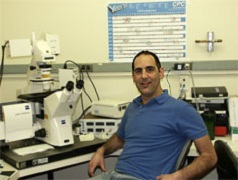

Eric Accili
Associate Professor
Canada Research Chair in Pacemaker Channel Biology
Member, Cardiovascular Research Group (Life Sciences Institute)
Postdoc – University of Milan, Case Western Reserve University
MSc, PhD Physiology – University of British Columbia
BSc Cell Biology – University of British Columbia
Email: eric.accili@ubc.ca
Phone: 604-822-2568
Office: 604-822-6900
Research Area
Studying the molecular mechanisms that are responsible for cellular pacemaking behaviour and that underlie the function and expression of “pacemaker” channels.
Research Relevance
The research aims to develop a better understanding of pacemaking electrical activity in cells, which may effect the treatment of conditions such as cardiac arrhythmias and epilepsy.
Understanding the Body’s Natural Pacemakers
Normal functioning of the heart and the brain depends upon specialized cells that act as pacemakers. In the heart, the pacemaker cells in the sinoatrial node set the heart’s beating frequency. The cells also generate rhythmic, spontaneous electrical impulses that can control muscle activity, certain automatic functions such as breathing, and behavioural states including arousal from sleep. Inappropriate pacemaker activity may lead to both inherited and acquired cardiac arrhythmias, and may also be involved in various neurological disorders such as epilepsy.
Canada Research Chair Dr. Eric Accili is the only scientist in Canada, and one of few in the world who focuses on “pacemaker” channels – the special membrane proteins found in the pacemaker cells of the heart and brain. Normally, positive ions flow through these channels and into the pacemaker cells, leading to repetitive activity.
In the heart, the pacemaker channels are the targets for hormones such as adrenalin. Adrenalin released during anxiety or exercise causes more ions to flow through the channels, thus increasing the heart’s beating frequency. In the brain, these channels are modified by neurotransmitters released by nerves, resulting in the modification of cellular pacemaker activity.
People with rapid heart rate are often treated with drugs known as beta blockers. These drugs, in addition to reducing heart rate, however, often compromise the strength of the heartbeat, which under certain conditions can be dangerous. What are needed are drugs that specifically block the pacemaker channels and reduce heart rate without compromising the strength of the heart. Understanding the basic mechanisms of pacemaker channel modulation, therefore, is a necessary first step in the design of therapeutic drugs.
- Akimoto M, Zhang Z, Boulton S, Selvaratnam R, VanSchouwen B, Gloyd M, Accili EA, Lange OF, Melacini GA. (2014) Mechanism for the auto-inhibition of hyperpolarization-activated cyclic nucleotide-gated (HCN) channel opening and its relief by cAMP. Journal of Biological Chemistry. 289: 22205-20. [IF 5.5].
- Peters CJ, Fedida D, Accili EA. (2013) Allosteric coupling of the inner activation gate to the outer pore of a potassium channel. Scientific Reports. 3: 3025. [IF 5.6].
- Macri V, Angoli D, Accili EA. (2012) Architecture of the HCN selectivity filter and control of cation permeation. Scientific Reports. 2:894. [IF 5.6].
- Jackson HJ, Hegle AP, Nazzari H, Jegla T, Accili EA. (2012) Asymmetric divergence in structure and function of HCN channel duplicates in Ciona intestinalis. PLoS One. 11: e47950. [IF 3.2].
- Whitaker GM, FC Lynn, Fulton C, McIntosh CH, Accili EA. (2012) Regulation of GIP and GLP1 Receptor Cell Surface Expression by N-glycosylation and Receptor Heteromerization. PLoS One. 7(3):e32675 [IF 3.2].
- Chow SS, Van Petegem F, Accili EA. (2012) Energetics of cAMP binding to HCN channels reveals negative cooperativity. Journal of Biological Chemistry. 287: 600-6. [IF 5.5].
- Peters CJ, Werry D, Gill HS, Accili EA, Fedida D. (2011) Mechanism of accelerated current decay caused by an episodic ataxia type-1 associated mutant in a potassium channel pore. Journal of Neuroscience. 31:17449-59. [IF 6.3].
- Hegle AP, Nazzari H, Roth A, Angoli D, Accili EA. (2010) Evolutionary emergence of N-glycosylation as a variable promoter of HCN channel surface expression. American Journal of Physiology-Cell Physiology. 298: C1066-76. [IF 3.8].
- Peters CJ, Vaid M, Horne A, Fedida D, Accili EA. (2009) The molecular basis for the actions of Kvb1.2 on the opening and closing of the Kv1.2 delayed rectifier channel. Channels. 3:314-22. [IF 2.4].
- Peters CJ, Chow S, Nazzari H, Angoli D, Cayabyab FS, Accili EA*. (2009) In situ co-distribution and functional interactions of SAP97 with sinoatrial isoforms of HCN channels. Journal of Molecular and Cellular Cardiology. 46:636-43. [IF 4.7].
- Macri V, Nazzari H, McDonald E, Accili EA. (2009) Alanine scanning of the S6 segment reveals a unique and cyclic AMP sensitive association between the pore and voltage-dependent opening in HCN. Journal of Biological Chemistry. 284: 15659-15667 [IF 5.5].
- Demos M, Macri V, Farrell K, Nelson T, Chapman K, Accili EA, Armstrong L. (2009) A Novel KCNA1 Mutation Associated with Global Delay and Persistent Cerebellar Dysfunction. Mov Disord. 24: 778-82. [IF 5.7].